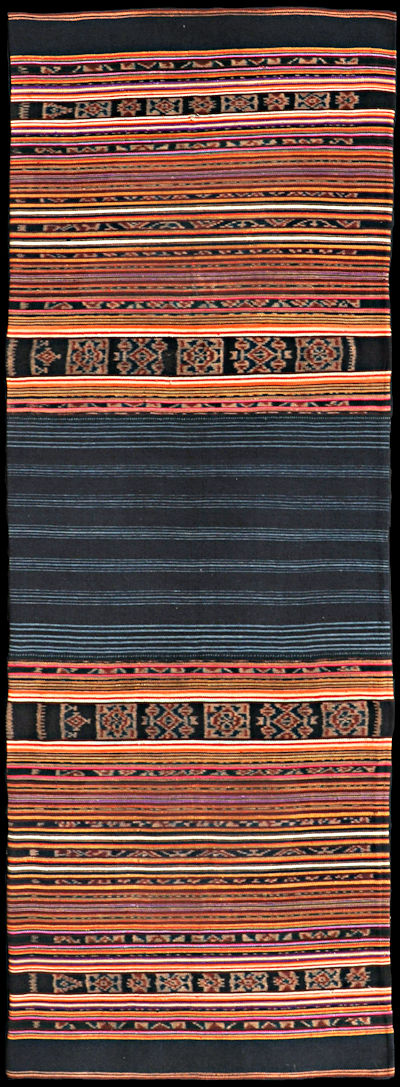| |
 
 | | | |
309 Solor Archipelago, Lembata
Wela (sarong) 
| | Locale: | Kedang, Eastern Lembata, most probably 'imported' from Ili Api. | | Period: | Circa 1900 | | Yarn: | Cotton, hand-spun, medium, and silk pinstripes | | Technique: | Warp ikat | | Panels: | 3 | | Size: | 65 x 180 cm (2' 1" x 5' 10") LW: 2.77 | | Weight: | 1005 g (35.5 oz), 429 g/m2 (1.41 oz/ft2) | | Design: | Three panel bridewealth sarong in characteristic Kedang design with mandatory indigo midfield. The widest ikated bands are decorated with ketipa, patola-inspired jilamprang motifs. This is the first time we have encountered such motifs on a Kedang cloth. Unusual are also the pale indigo stripes in the midfield, which is normally solid indigo. Bridewealth sarongs are often longer than a normal sarong and when worn (for ceremonies) the top would be folded down towards the middle so as to fit the bride. There was a taboo (Cf. Barnes) on weaving in Kedang in northeast Lembata, the area around Balauring, until World War II, the only place excepted being the coastal village of Kalikur, peopled by Muslim immigrants. However the best such bridewealth sarongs, such as this one, were 'imported' from the Lembatan village Ili Api, which lies on a peninsula a little further west. | | Comment: | The finest Kedang encountered in forty years of collecting. In other parts of Lembata, this would be called a kewatek nai telo, 'three panel sarong', but in Kedang it would probably be called a wela. The cloth is dense and heavy and the ikat is of high quality, with clear drawing in a firm hand. To assure that this sarong would stand out it was lavishly enriched with pinstripes in letros, commercial silk, available on the island before World War II. The range of colours encompasses all colours of the rainbow - or as many of them as were available in the Chinese store. This weaver was not just able, so was also rich and keen to show it, her husband most likely a powerful figure. A true pusaka, in very good condition for its age. One small area (abt. 4x4 cm) of solid indigo was woven in with hand-spun cotton, by the look of it a long time ago. Ex collection August Flick. | | Background: | Chapters on Solor Archipelago and Lembata. | | Published: | Ikat from Timor and its Outer Islands, 2022.
| | Compare: | 025 178 284 | | Sources: | Very similar to Ili Api produced KÚdang kewatek depicted in Hamilton, Gift of the Cotton Maiden, 8-23, also from the August Flick collection. Very similar to one in the Art Institute of Chicago, Bakwin Collection, No. 2002.1001, depicted in Khan Majlis, The Art of Indonesian Textiles, Fig. 48, dated as early 20th and identified as Ili Api, made for use in Kedang. Similar to ca. 1900 example shown in Khan Majlis, Woven Messages, Fig. 190, which has a nearly identical main ikated band. Similar to late 19th C. piece sold by Van Ham and Klefisch, 4 Dec. 2014, lot nr. 248, but nearly half a meter longer. Also similar to another example from the same period sold by the same firm on 13 June 2017, but again a third longer. | | |

©Peter ten Hoopen, 2025
All rights reserved.
|
|


